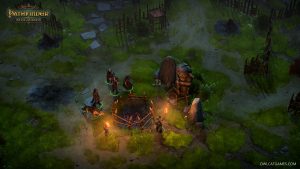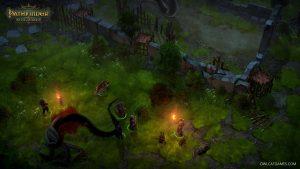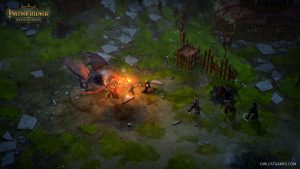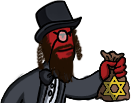Pathfinder: Kingmaker Interview
by
Johnathan Stringer · Published September 28, 2018 · Updated September 28, 2018
Pathfinder: Kingmaker is a new RPG based on the pen and paper game and developed by Owlcat Games. Owlcat Games has enlisted the help of accomplished writer and designer Chris Avellone, and Chris and Owlcat Games creative director Alexander Mishulin answer some interview questions about the game, which is available now on PC.
Johnathan Stringer (RPGamer): Chris, what has your role been in the development of Pathfinder: Kingmaker?
Chris Avellone: Alexander Mishulin is the Creative Director, Alexander Komzolov is the lead writer. I’m one of the writers reporting to the Alexanders, but I’m not the lead writer on the game, no, and there are many other writers on the project for sure.
I worked with the Alexanders to do passes of the story to expand it from the pen and paper roots so people who had played the original adventure path would still have some new content. We worked out the underlying theme for the story as well. In addition, some elements of the pen and paper path were taken in new directions to make them more suited for evil playstyles, which was fun. I also worked with the designers on setting up the pen and paper quest arcs with the new companion quests across the game (the companions add a lot), and gave feedback on the companions as well.
As for writing companions, I got the parameters of the “goblin rogue” (the companions weren’t named at the outset, and I did help with naming companions). From that, I was able to flesh out additional elements of his backstory, look, etc. and then I wrote Nok-Nok from start to finish. Nok-Nok’s one-paragraph character arc had already been approved by the license holder before I came on board (and same with some of the other story elements), but Alexander Komzolov and I agreed to change aspects about Nok-Nok afterwards even though his general arc remained the same (and some specific conclusions to his companion quest).
I also did the style guide, the module (on 2nd draft now), helped coordinate some aspects of the editing team (we had two editors who worked on the English versions), helped with UI text, and writing and edits on about 150+ other characters.
I didn’t work on the systems for the game, so a lot of the questions to follow that involve systems Alexander Mishulin will weigh in, as he was heading those up in addition to overseeing the rest of the product.
I like working with Owlcat a lot, it’s been a good experience. I hope more
Pathfinder games follow after
Kingmaker. : )
JS: Kingmaker is an adventure path (epic campaign) and two things made it stand out from the standard adventure. First, players spend a lot time exploring vast lands (wilderness, plains, swamps, etc.) square mile by square mile. Second, players found their own city and eventually become kings. They made decisions, gave direction, fulfilled critical roles in the kingdom, and defended their lands from attackers (some on a large scale). How will this game capture that?
CA: The exploration aspect is done via world map in
Kingmaker, similar to the pen and paper version, but random encounters and placed/scripted encounters do occur as you explore more and more of the Stolen Lands — and as you advance through the game, more of the Stolen Lands open up to you as you meet various challenges (other territories can swear fealty to you, for example).
For the city-building/kingdom aspects, Alexander Mishulin can speak more to the mechanics, but because the adventure path had kingdom construction as part of the arc, a design was set forth and implemented so the player eventually gains a territory of their own, then depending on their choices (narrative, mechanical, and even alignment) you gain access to new structures you can build, new artisans you can attract to your kingdom, and customize your capitol city based on your playstyle — each player can create a capitol city of their own.
JS: How does the game differentiate or transition between adventuring and acting as the king? How do you deal with pacing in the story and gameplay with having these two different gameplay modes?
CA: The pacing is such that kingdom events are introduced where the player can choose to weigh in on criminal or political matters (or forsake/ignore them – or assign an advisor or companion to deal with them if they don’t feel like involving themselves), and those moments are interspersed with adventuring/dungeon crawling elements.
With the “justice of the King/Queen” moments, those are usually handled via dialogue interactions in your throne room, often as consequences of what you may have done or chosen while adventuring.

 JS: I noticed in the trailer that your town and kingdom’s aesthetics will reflect your alignment. With that in mind, many similar styled RPGs in the past have struggled making a compelling evil or anti-hero approach to the campaign. How will playing an evil character differ or stand out against playing the “good guy”?
CA
JS: I noticed in the trailer that your town and kingdom’s aesthetics will reflect your alignment. With that in mind, many similar styled RPGs in the past have struggled making a compelling evil or anti-hero approach to the campaign. How will playing an evil character differ or stand out against playing the “good guy”?
CA: It’s a common challenge in RPGs — the evil (lawful or chaotic path) can sometimes default to simply demanding more money from quests or threatening to kill/killing everyone you meet.
While there are instances where you can do these things, Alexander Mishulin and Lead Writer Alexander Komzolov (and the writing team) created moments that I think evil players will find interesting – and note that “evil” may not simply mean being psychotic, but also being more willing to deal with monsters and creatures that others (Good or Neutral characters) would dismiss as evil and see them as nothing more than threats, and then evil characters seeing the rewards stemming from that.
Plus, there’s a certain narrative value and shift in the experience through the companions that can join you, and the ones that you may drive away with your behavior — some companions are far better suited to evil parties, and as such, players role playing good characters may not see those arcs play out in the adventure (but they will see other companion arcs evil characters may not see).
For me, while I don’t want to spoil anything, there was a critical moment in one of the early chapters where something that was never in the pen and paper adventure path is permitted for evil players, and when I saw the scripting layout for it, I was pretty impressed (if someone finds it during release, I’ll happily speak to it).
JS: I have heard from developers of many of the Dungeons & Dragons PC RPG adaptations that capturing all the pen and paper or tabletop rules into video game form can be very difficult. What has been the approach for Kingmaker in this regard? Are there any rules that have been scrapped or heavily changed to make the game more playable in this format?
Alexander Mishulin (Owlcat Games): In my experience, working with established rule sets is not that difficult, as it already provides the game’s system with robust framework. Nevertheless, there are some difficulties to overcome. First and foremost, there are a lot of rules in
Pathfinder, so we had to decide which will get into the game, because we could not feasibly implement all of them. Our preference was given to the class abilities, feats, and spells that allow builds favored by tabletop players. The second primary issue was making the system accessible to new players, while still being true to the tabletop experience. We decided to provide help to the new players in the form of pre-generated characters, automatic level-ups, and advisement on skills and feats.
JS: Pathfinder is a turn based game with a lot of intricacies. Many feats and class features tie into attacks of opportunity, interrupts, initiative, etc. While these features work well with a turn-based game, it seems it would be quite the challenge to add these elements to a pseudo real-time combat system. What is your approach there?
AM: Yes, making such systems and mechanics work with the real-time combat can be tricky, but they are an essential part of the system. If we look at the reason these systems are in place — they generally simulate reaction to certain actions while it is not your turn, as they are simulating real-time reaction in the turn based system. So, some of the changes come easier (at least until a character performing them is busy with other actions). Initiative was rather easy to implement in the form of a delay before the first action in combat. Attacks of opportunity are mechanically also simple, but we struggled a lot with informing the player about them, and with adding animations to them. For some time, we were even considering slowing time for a couple of seconds to show that such an attack happened, but decided to stick to the more old-fashioned solution.
For most of the systems, our approach was to understand the meaning of the system in the tabletop game, transfer that meaning to the real-time game, and make sure it is interesting to play and provide enough choices in battle or in character builds.
JS: In the pen and paper game, spells cast instantly on the character’s turn, and can be precisely placed. In other real-time, isometric RPGs, a spellcaster could take seconds to cast his spell, and no guide was given as to the area of effect. Enemies and allies would move around during those precious seconds causing tactical issues and concerns not found in the pen and paper counterpart. What will be the approach of Kingmaker regarding spellcasting?
AM: As soon as you start casting area of effect spells, you will be prompted to select a location for the spell. While doing so, you will be able to see whom you will hit at that particular moment of time. In addition, a marker will be placed on the ground. While the spell is being cast, you can pause the game and move the marker within spell range, and the area of effect will move accordingly. This could be done up until the spell is let loose by the caster. Usually, it takes one or half of a second for a spell to arrive to its destination, and that is the only time you are lacking control over the spell.
To sum things up, you can fine tune spell destination while you are waiting for your spell caster to finish the spell, and you have to plan for one additional second for the spell to arrive, in case the situation on the battlefield is especially dynamic.

 JS: On a similar note, non-combat skills have typically been poorly translated from pen and paper to video games. Often building your character or getting NPCs with these skills are a waste. How are these types skills implemented or made useful?
CA
JS: On a similar note, non-combat skills have typically been poorly translated from pen and paper to video games. Often building your character or getting NPCs with these skills are a waste. How are these types skills implemented or made useful?
CA: They can be, yes, but sometimes you’re right, some skills (or even attributes) need some reworking because of the digital gameplay experience (we had this problem with the Speech skills in
Star Wars: Knights of the Old Republic II, for example – because the player was the only one could converse with NPCs, the Speech check for companions was a dead stat).
AM: We are using a consolidated version of skills from the
Pathfinder Roleplaying Game system, which means most skills do more than one thing in the game, so they are used more often. When we were designing the game at early stages of development, we strived to have at least one mechanical (combat or otherwise) application of a skill, and another application that could be useful while exploring the locations or in dialogs. For example, the Mobility skill allows the character to reach places otherwise unreachable (like running across the fallen trunk to reach a platform with loot), while also increasing the bonus from Defensive Fighting, which could be useful in combat. We planned the “exploration/dialogue” uses for each skill and added them to locations and dialogs to ensure that they find their uses in throughout the whole game.
During most events in the game, the character from the group with the best skill score is selected to perform the particular task. However, the game has special illustrated events that happen on the pages of the book. During such illustrated events, you will have to select a character to perform a task separately from the rest of the group. Once chosen, only this particular character gets to use skills for all the upcoming checks. Therefore, it might be important to have characters that are decent in various skills to get the best results from such events.
JS: I understand that the player creates the “main character” and recruits party members. Some people may want to create an entire party from scratch and run with that. Will that be an option?
AM: There is a system that allows you to hire mercenaries (which are essentially characters you hand make for your party). We were asked by a lot to allow players to run with a completely custom party, and this is our way of doing so. It is not really recommended though, as you will be skipping a lot of companion interactions (and that will make your experience a bit lacking, compared to the run with companions in your party), but it is possible to do. You can also try to solo, although in several episodes you will have to work with a couple of party members due to story reasons, but apart from that you can try to do that.
JS: For those who do not play Pathfinder or pen and paper games, what should attract them to Pathfinder: Kingmaker? Who else is the target audience for this game?
CA:
Kingmaker is a great isometric RPG and features a lot of changes when it comes to stronghold mechanics — also the challenge faced by players is somewhat unusual, as you’re juggling almost three (or more) different threats at once, which is something rulers are sometimes faced with. If you enjoy RPGs, and a layer of kingdom building that is influenced by your narrative choices,
Pathfinder: Kingmaker is for you.
We would like to thank both Chris and Alexander for taking the time to answer our questions and provide us with a better look at the design decisions behind
Pathfinder: Kingmaker. RPGamers who are interested in pen and paper based isometric RPGs should take notice and give this game a look.























![Glory to Codexia! [2012] Codex 2012](/forums/smiles/campaign_tags/campaign_slushfund2012.png)














